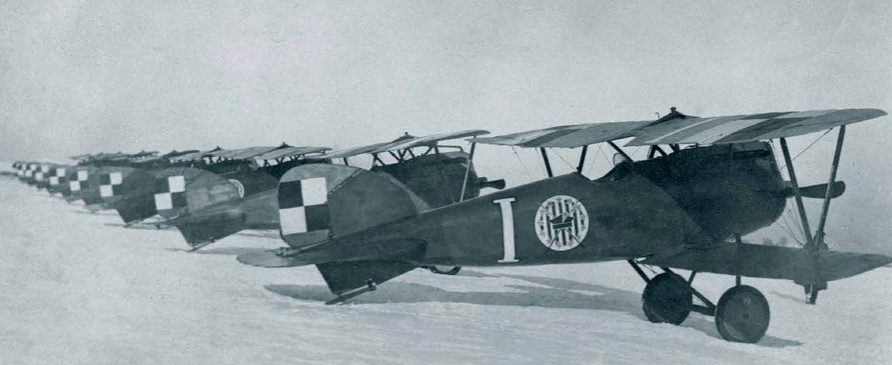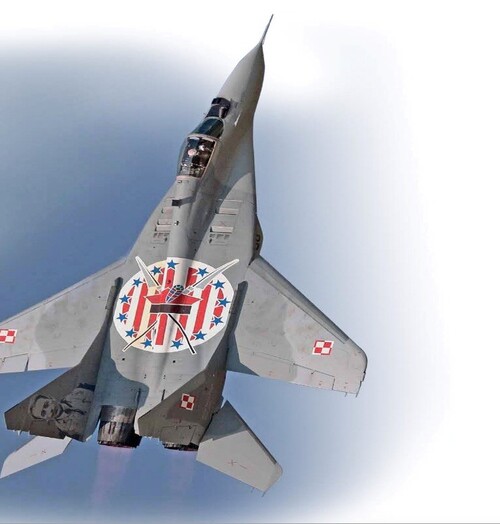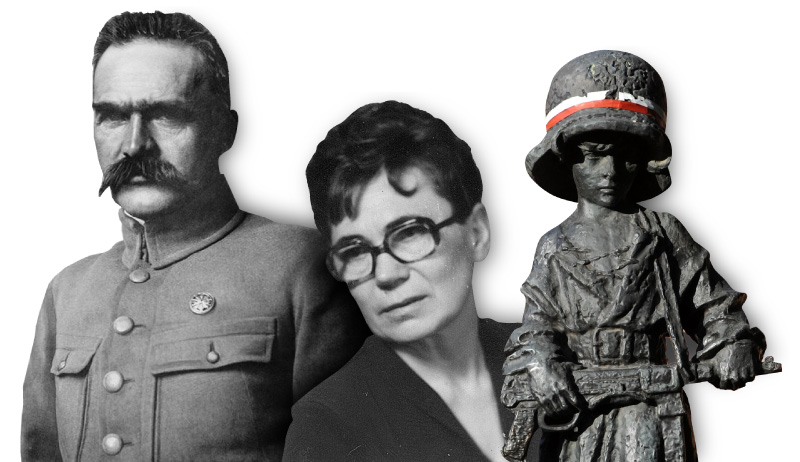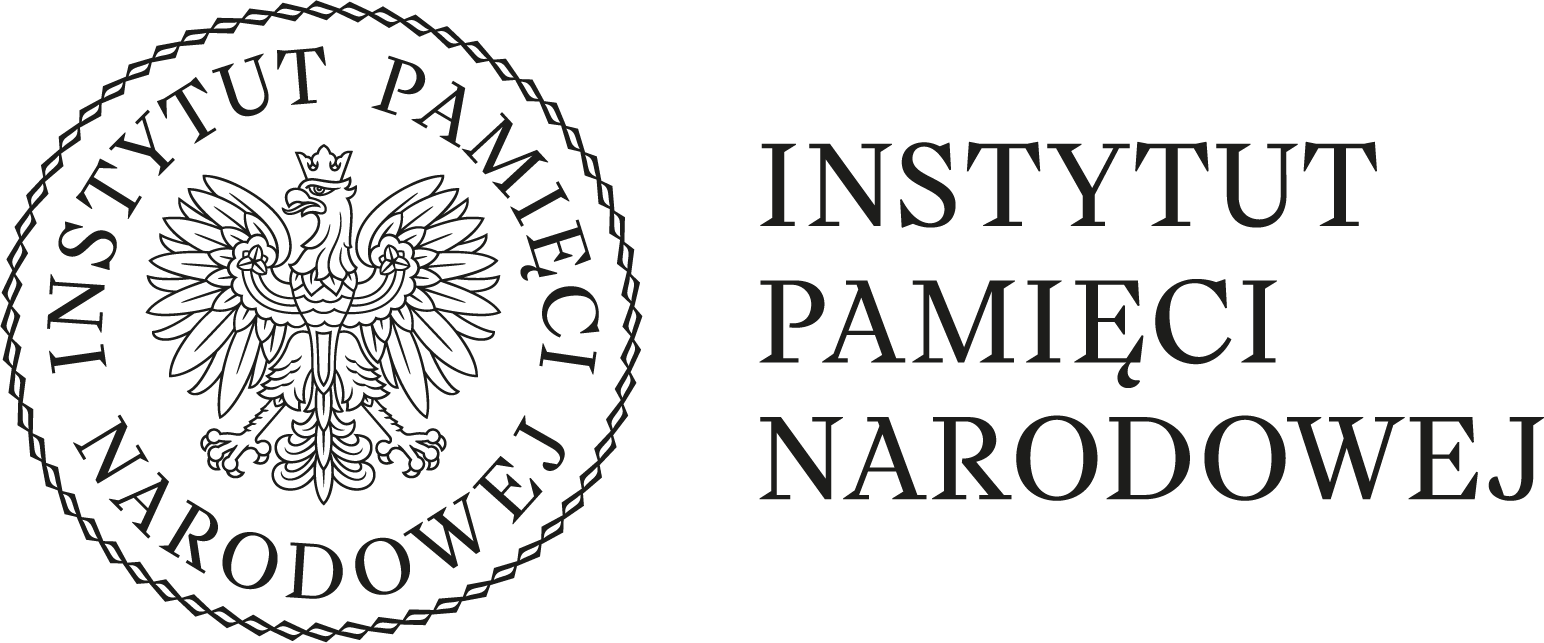It was created in November 1918 in Cracow as the 3rd Air Escadrille and soon after was sent to Lviv where Poles fought against the Ukrainians. At the time, Polish military units (including the air units) were created wherever Polish soldiers were. One of the side effects of such enthusiasm, as well as of communication issues, was the doubling of names: air squadrons called the “first”, “second”, “third” etc. were established at the same time at different airfields. As part of the reorganisation of the Polish Air Force, the “3rd Air Escadrille” was given the number 7.
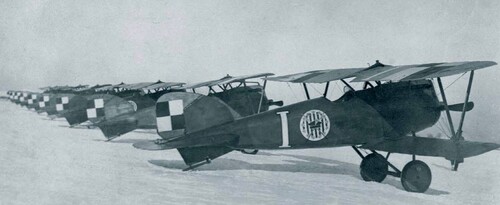
Planes of the 7th Escadrille decorated with the Kościuszko Emblem, at the Lewandówka air field in Lviv, 1919. A historical paradox: American airmen fighting in defence of Poland flew on Albatrosses – fighter planes of German and Austrian production; not long before, they fought against these in the air over the western front of the First World War! In the foreground, the aircraft no. 1 operated by Cedric Fauntleroy. Fauntleroy is currently commemorated on MiG-29, tactical no. 42
They wanted to pay off a debt
No more than a year later, when Poland was on the brink of war against Bolshevik Russia, a group of American pilots, led by Maj. Cedric Fauntleroy and Capt. Merian Cooper, volunteered to join the Polish Air Force. That way, they wanted to pay off their country’s debt towards the nation which gave them two, great heroes: Kościuszko and Pułaski. In October 1919, they were assigned to the 7th Escadrille stationed in Lviv, and Fauntleroy was appointed as its commander. Later, a legend was created that it were the Americans who supposedly created the unit from the beginning. However, it wasn’t true – when the US pilots were assigned to the unit, the 7th Escadrille had already conducted nearly 200 combat flights.
It is worth mentioning, that prior to the USA joining the First World War, many American volunteers joined the French Air Force creating the so-called Escadrille La Fayette to honour the French General who fought in the American Independence War in the 18th century. Similarly, when the Americans joined the 7th Escadrille in the year 1919 it received the name of the Polish General in the American army – Tadeusz Kościuszko. Of course, from the Polish standpoint he was also an appropriate patron given the fact that at the end of the 18th century he also led the Polish troops against Tsarist Russia.
One of the Americans, Lieut. Elliott William Chess, designed the emblem for the Escadrille: white and red stripes for the background and thirteen stars, taken from the US flag, symbolising Kościuszko’s role in the war for independence of the United States of America. The images of crossed scythes and a Cracow cap (krakuska) – the symbols of the 1794 Kościuszko Uprising – were added. This emblem was painted on the planes and metal badges were worn on the uniforms. The emblem gained an unofficial name of “the Scythe”, and the squadron’s pilots were called “the Scythemen”.
The 7th Kościuszko Escadrille did not have the opportunity to fight in the air, but it was very efficient against the Bolshevik ground troops.
When Poland was on the brink of war against Bolshevik Russia, a group of American pilots, led by Maj. Cedric Fauntleroy and Capt. Merian Cooper, volunteered to join the Polish Air Force. In October 1919, they were assigned to the 7th Escadrille stationed in Lviv, and Fauntleroy was appointed as its commander.
In August 1920, it was one of the several air units which slowed down the march of Budyonny’s Cavalry Army to Lviv, as the army had no military units capable of defending the column against planes. Thanks to the pilots the city was not attacked – it was the first case in history when the air force defended an important strategic point from the land troops on its own.
After the Polish-Soviet war had ended, the Americans returned to their homeland, and the Kościuszko Escadrille once again became an entirely Polish unit. Nonetheless, it retained the traditions of friendship between the two nations as well as the symbolic emblem which survived even when between the 1920s and 1930s other units changed their emblems to simple, geometric identifications due to yet another reorganisation. The work of the Kościuszko Escadrille in the 1920 war became the subject of the feature film entitled The Starry Squadron, directed by Leonard Buczkowski and written by Janusz Meissner. The picture appeared on the silver screens in 1930 and instantly became a huge hit.
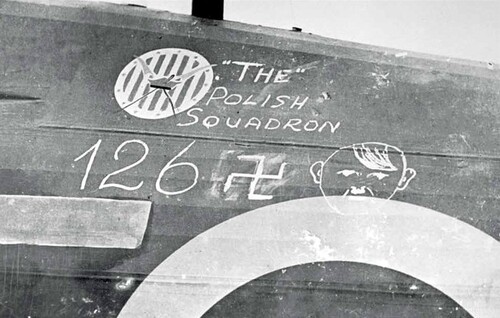
October 1940 – the Kościuszko Emblem on the body of the Hawker Hurricane plane of the 303rd Squadron; underneath it the number of confirmed victories of the unit, according to the data of the RAF command, written with chalk. Another irony in the history of the unit is the fact that the squadron so famous for efficiently defending the British Isles had Tadeusz Kościuszko as its patron – an American General who decimated the British in the Independence War of the USA.
In the beginning of the 1930s, one of the squadron’s pilots, Lieut. Stanisław Latwis, composed the March of the Kościuszko Escadrille to the words of Aleksandra Zasuszanka. Soon, the song became the anthem for the entire Polish Air Force and still is to this day, commonly known as the Aviators’ March. Its origins are apparent from one of its verses:
Kościuszko’s silver scythes shine on a plane,
The shape of the four-cornered cap stands out on the banner’s starry background.
The two countries unite in a brotherly act,
Blood for blood, nation for nation.
During the interwar period, the Kościuszko Escadrille changed its number two times: first, it became the 121st Escadrille, and then the 111th; under the latter it took part in the fights in September 1939.
No. 303 Squadron
Unfortunately, Poland could not resist two enemies, especially without the help of any of its allies. Pilots, along with thousands of other soldiers, went to France by various routes and after it fell – to the British Isles to continue the fight against the Germans. When Polish troops were formed in Great Britain during the Battle of England, one of them – no. 303 – became the embodiment of the Kościuszko Escadrille.
According to the official reviews of the British command, no. 303 Squadron was the most efficient allied unit during the Battle of England.
Many pilots who went to war with the 111th Escadrille then served among the ranks of the 303rd – including many engineers without whom it would be impossible to score so many great victories in the air. The traditional emblem – the “Scythe” – was painted on the squadron’s planes and worn on the uniforms of its personnel.
According to the official reviews of the British command, no. 303 Squadron was the most efficient allied unit during the Battle of England which took place in the summer and autumn of 1940. It is a great historical paradox that an air unit so distinguished in the defence of Great Britain bore the name of Tadeusz Kościuszko – a General who helped the Americans defeat the British army and gain independence from the United Kingdom!
When recalling the greatest moments in the 303rd Squadron’s history, it needs to be stressed that it was the Battle of England which brought the first strategic loss for the Third Reich. Contrary to the German propaganda, it was not at Moscow by the end of 1941 where Hitler first learned that he couldn’t conquer every country but a year before that, over London. And in this battle, which was so crucial to the course of the war, Poles played an important if not a decisive role.
In the beginning of the 1930s, one of the squadron’s pilots, Lieut. Stanisław Latwis, composed the March of the Kościuszko Escadrille to the words of Aleksandra Zasuszanka. Soon, the song became the anthem for the entire Polish Air Force and still is to this day, commonly known as the Aviators’ March.
It is also worth mentioning, that while they had amazing successes in air fights, the pilots of the 303rd Squadron also had – proportional to their numbers – much less losses in men than their British brothers in arms. Opposed to the German propaganda picture of archaic Polish cavalrymen charging tanks, Poles turned out to be world-class experts in operating the most modern types of machines.
Unfortunately, the decisions on the post-war fate of Poland were made not in air or land battles but in politicians’ offices where we were dramatically weak, and thus Poland became under the Soviets’ control for long years.
The most obvious result of that was breaking the traditions of military units and attempts to erase the memory of the most glorious cards of Polish war history. The Kościuszko Escadrille also fell victim to these practices. During the worst Stalinist period (1948-1955) it was forbidden to publish the book by Arkady Fiedler Squadron 303. All known copies of the film The Starry Squadron were destroyed as well.
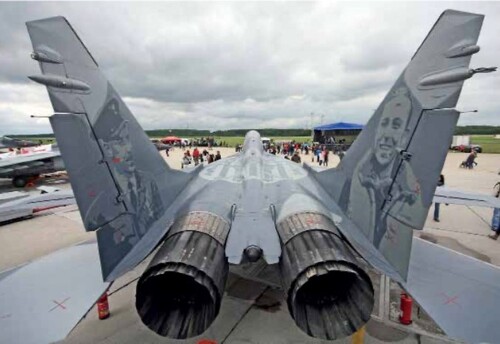
Each and every MiG-29 of the 23rd Air Base in Mińsk Mazowiecki has a three-metres wide Kościuszko Emblem painted on its top, and on the inside of the tail a portrait of a patron of the plane. On MiG-29 no. 59 it is Zdzisław Henneberg, an ace of the 303rd Squadron who got many victories in the Battle of England and then commanded it since February 1941 until his death in April, the same year. (photo: Paweł Bodnaryk)
It wasn’t before the fall of Communism in Poland, in the beginning of the 1990s, when the beautiful traditions of the Kościuszko Squadron were restored. Thanks to the joint initiative of the veterans of the 111th and 303rd Squadrons and the modern fighter jet pilots the traditions were brought back by the 1st Fighter Regiment “Warsaw” (1st PLM) in Mińsk Mazowiecki. In May 1993, the 1st PLM officially took over the traditions of the pre-war 1st Aviation Regiment in Warsaw, which the 111th Kościuszko Escadrille was part of. Three years later, the veterans gifted the Mińsk unit with the 303rd’s memorabilia, including the most precious one – the insignia of the War Order of Virtuti Militari which the squadron was awarded with.
The 23rd Air Base
After another three years, in 1999, it were the airmen from Mińsk Mazowiecki who became the first Polish soldiers officially serving in the NATO defence system. In 2006, they began taking part in regular missions abroad under military contingents of the Baltic states. Currently, following another reorganisations of the Polish Air Force, the historical name and emblem is assigned to the 23rd Air Base (23 BLT) stationed in Mińsk Mazowiecki.
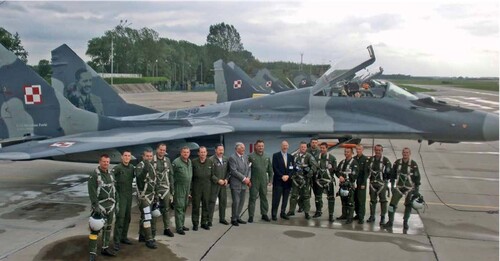
On August 27th 2012, the 23rd Air Base was visited by Philip Methuen-Feric and Witold Urbanowicz Jr., the sons of two great pilots of the 303rd Squadron. In the picture, they are posing with the modern pilots in front of the MiG-29 no. 111; between the two sons stands the commander of the 23rd BLT, Col. Maciej Trelka. The plane was the first ever painted air craft as part of the “Warsaw Scythemen” project. Its patron became Mirosław Ferić – a fighter ace (photo: Wojtek Matusiak)
In 2009, to commemorate the 90th anniversary of the Escadrille taking the name of Tadeusz Kościuszko and the approaching at the time 70th anniversary of the 303rd Squadron’s participation in the Battle of England, the Kościuszko emblem three metres in diameter was painted on top of one of the fighter jets of the formation. MiG-29 no. 15 became the sensation of the annual air show in Góraszka, near Warsaw, and then of many other air shows in all of Europe. The pilots from Mińsk Mazowiecki proudly presented the praiseworthy traditions of their unit.
Three years later, in 2012, a new, unprecedented project of commemorative painting of all the aircrafts of the unit began. Each plane received a patron, an outstanding pilot of the Kościuszko Escadrille who distinguished himself during the fight for Poland’s freedom in 1920 in the 7th Escadrille, during the Second World War among the ranks of the 111th Escadrille or in the west – in the 303rd Squadron. Portraits and names of the patrons were painted on the planes’ tails and on their tops – the Kościuszko Emblem.
All of this special painting was done with grey paints so not to break the planes’ camouflage. Only on two aircrafts, dedicated to air shows, the multi-coloured emblem was painted. The project was called the “Warsaw Scythemen” to honour the old nickname for the pilots of the famous escadrille. All the project and painting works were done by volunteers, guided by the project’s initiators: Robert Gretzyngier and the author of this article.
The article comes from no. 1-2/2017 of the “Biuletyn IPN”
